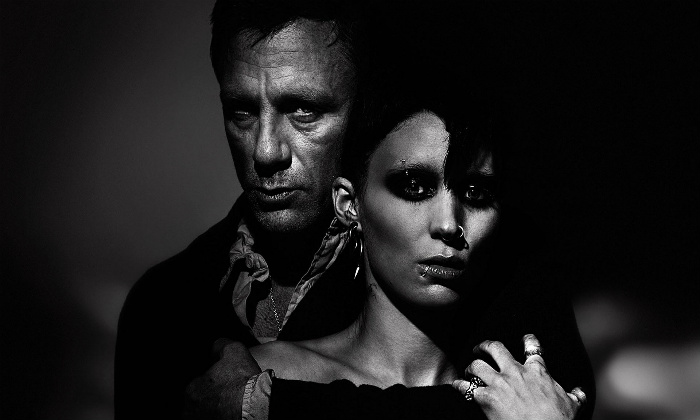The “feel-bad movie of the season” – that’s how one of the early trailers accurately advertised the movie: The Girl with the Dragon Tattoo (2011), Hollywood director David Fincher’s finely honed drama-thriller adaptation of the award-winning crime novel by Stieg Larsson. David Fincher’s impressive repertoire includes films like Seven, Fight Club, Panic Room, Zodiac, The Curious Case of Benjamin Button and The Social Network. Now his 2011 offering, The Girl with the Dragon Tattoo, gives audiences another big-flick to relish.
The original Swedish title of the novel translates to Men Who Hate Women, which reveals its theme of sexual violence against women, stemming from an incident when Stieg Larsson, at the age of 15, had to helplessly witness the gang rape of a young girl, Lisbeth. He christened the young main character of his books, Lisbeth, who is a victim of rape herself. The crime novel, The Girl With the Dragon Tattoo, is the first of the immensely popular ‘Millennium’ trilogy. Before his stint as a fiction writer, the author was a journalist, which is evident in his journalistic style, as he begins each chapter with statistics about violence against women in Sweden. This compelling tale transports the reader to rural Sweden, where they plunge into the depths of a gripping crime story.
There has also been another Swedish film adaptation of the book in 2009 by director Niels Arden Oplev. However, in no way is Fincher’s adaptation a copy of the earlier Swedish movie, or the book. It goes without saying that its roots are firmly grounded in the source material but the film stands strong on its own merit. Perhaps one can even go further to argue that thanks to a bigger budget and an auteur behind the camera, the 2011 film over-takes its predecessor a little. Also, Fincher’s characters are more fleshed out as emotionally complex individuals, while the 2009 film’s characterisation was more straightforward.
Fincher’s 2011 film adaptation of the internationally best-selling novel explores a man’s mission to find out what happened to a girl who has been missing for the last 40 years, with the distinct possibility that she might have been murdered. Financial reporter Mikael Blomkvist (Daniel Craig) is engaged by Henrik Vanger (Christopher Plummer), a wealthy Swedish industrialist, to investigate the disappearance of his beloved sixteen year old niece, Harriet. Vanger suspects that his niece might have been murdered by a family member. The investigation leads the journalist to remote, wintry Hedeby, an island on the coast of Sweden. Before offering Blomkvist the job, Vanger has the writer’s background checked by Lisbeth Salander (Rooney Mara), an expert computer hacker. Eventually, Blomkvist finds out that Lisbeth was investigating him and joins forces with her to help dig up the dirt on the Vanger family. An attraction between the lead pair forms as he admires her computer skills and photographic memory; and she is impressed by his forthrightness and style of investigation. What’s more, this unusual pairing seems somehow right as both their moral codes are strong, specially regarding their stand on the subject of violence against women. But they don’t come together until the movie is well underway, and the dense plot alternates the two characters’ individual converging storylines. As the two of them begin to trace a chain of homicides from the past into the present, they find themselves pupil deep in a dark, toxic world in a cold bleak Scandinavian setting.
Screenwriter Steve Zaillian adapts Larsson’s novel deftly by condensing a six hundred page book into a two-and-a-half hour motion picture, making some small and perhaps necessary changes in the plot and characters. One would assume his biggest challenge would have been to translate something as cerebral as solving a puzzle to the visual medium of film. He succeeds in this daunting task with the clever use of photographs, paperwork, voiceovers, flashbacks and even an effective soundtrack that allows the audience to come to the same conclusions at the same time along with the leading pair Mikael and Lisbeth.
Although Mikael Blomkvist, played by the biggest star in the film, ie the famous James Bond, Daniel Craig, is the central character and has the most screen time, he is by no means the scene stealer of the film. That mantel undoubtedly belongs to Lisbeth Salander, ie Rooney Mara and her close-to-the-bone portrayal of the tiny, brilliant, pierced and tattooed hacker. A ward of the state due to a violent childhood spent in and out of mental institutions, Lisbeth gets a new guardian who controls her finances and demands sexual favors in exchange for her money. However Salander, far from being a victim, regains total control over her finances and sexuality in a couple of memorable graphic scenes. She draws the audience’s attention with her underlying vulnerability as a little girl trapped in a woman’s body. While being hard, cold and merciless, she also conveys a fragility that wins your sympathy and your vote.
The film conveys an extremely suffocating air of danger and dread, while keeping you riveted, as you travel into the sinister darkness of a chamber of horrors. David Fincher reminds one of David Lynch who seems to share his belief that there is rot and corruption hidden in society breeding evil at every corner. From the flashy opening credits to Enya’s Orinoco Flow, and plenty of suspense and tension, the film delivers what it promises.


